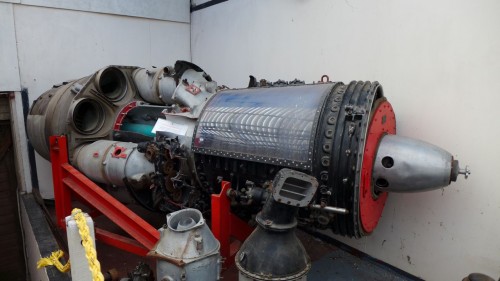
Click Here for Full Screen Image - Click Here to Download Image
 |  |
| Lot number | 114 |
|---|---|
| Hammer value | £600 |
| Description | Rolls-Royce Avon Jet Engine |
| Year | c.1960 |
| Colour | Silver |
While most people associate Rolls-Royce with the manufacture of some of the finest luxury cars in the world, it is perhaps less well-known that the name has been synonymous with the production of aircraft engines for over a century.
Rolls-Royce produced its first aircraft engine, the Eagle, in 1914. Around half the aircraft engines used by the Allies in World War One were made by Rolls-Royce and by the late 1920s, aero engines made up most of the firm’s business. Probably the most famous of all the Rolls-Royce piston engines was the Merlin, a handsome 27-litre V12 engine which powered some of the finest aircraft of WW2 including the Spitfire, Hurricane, Mosquito and Lancaster. Built under license by Packard in the USA, it was also fitted to the famous American fighter, the P-51 Mustang.
In the post-World War Two period, Rolls-Royce was a pioneer of the jet engine and made significant advances in gas turbine engine design and manufacture. The Rolls-Royce Avon was the first axial flow jet engine designed and produced by Rolls-Royce. The Avon design team was headed by Cyril Lovesey, who had previously been in charge of Merlin development. Intended as a jet successor to the Merlin, the Avon went on to become one of their most successful post-World War Two engine designs. It was used in a wide variety of aircraft, both military and civilian, as well as versions for maritime power.
The engine eventually entered production in 1950, the original RA.3/Mk.101 version providing 6,500 lbf thrust in the English Electric Canberra B2 (on 21 February 1951, an RAF English Electric Canberra B Mk 2 powered by two Avons made the first un-refuelled non-stop transatlantic flight by a jet). Similar versions were used in the Canberra B6, Hawker Hunter and Supermarine Swift.
Uprated versions soon followed, the RA.7/Mk.114 producing 7,350 lbf in the de Havilland Comet C2, the RA.14/Mk.201 of 9,500 lbf in the Vickers Valiant and the RA.26 of 10,000 lbf used in the Comet C3 and Hawker Hunter F6. An Avon-powered de Havilland Comet 4 flew the first scheduled transatlantic jet service in 1958. The line eventually topped out with the RA.29 Mk.301/2 producing 12,690 lbf and 17,110 lbf in afterburner, which was used in later versions of the English Electric Lightning. Production of the Avon aero engine version ended after 24 years in 1974.
This Avon jet engine has been on display at Stondon for many years and would make a great talking point in any man cave. Use a bit of ingenuity and you could turn it into a piece of furniture. Use a bit more ingenuity and you could fly across the Atlantic with it at 600mph!
This lot will be available to view at Stondon Museum (SG16 6JN) on Friday 5th June. Although this vehicle will be offered for sale at Brightwells (HR6 0DE) it will need to be collected from Stondon.